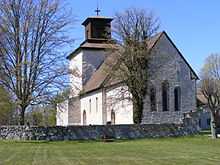Vamlingbo Church

Vamlingbo Church (Swedish: Vamlingbo kyrka) is a medieval Lutheran church on the Swedish island of Gotland, in the Diocese of Visby.
History
The earliest church on the site was a stave church, later replaced by a Romanesque stone church. Of these first churches nothing remains, except for some Romanesque reliefs incorporated in the southern wall of the present church, and the baptismal font, made by the master sculptor known as Master Byzantios.[1][2]
The presently visible church is a comparatively large Gothic building, dating from the middle of the 14th century. Only the tower is later, built during the 14th century but heavily damaged by a lightning strike in 1817. The upper part of the tower, including the roof lantern, therefore dates from 1820.[1][2]
The church is one of the largest churches on Gotland, which is probably because the large parish was at the time one of the richest on Gotland.[1][2] It is however also possible that the unusual size of the church can be explained by that the church, like Lau Church, may have been used by Dominican monks to preach crusades against pagans in present-day Estonia and Latvia.[1]
No major alterations have been made to the church since. Archaeological investigations[1] and a renovation was carried out in 1960 to 1961.[2]
Architecture

The church is a hall church[1] of a type quite common on Gotland. The nave of the church is spacious and broad, divided into three parts by four sturdy pillars. The stone masons that built the church have alternated red and grey limestone in the pillars and other details, creating an unusually colourful interior. On its northern wall are a set of fine medieval frescos, depicting a scene in which the archangel Michael is weighing the soul of Emperor Henry. The picture dates from the middle of the 13th century and is considered to be one of the largest and most unusual frescos on Gotland. It has been suggested that St. Michael was the patron saint of the church. Other, less dominating frescos in the church depict pictures of saints and apostles, and purely decorative painting.[2]
Of furnishings, the aforementioned baptismal font is perhaps the most noteworthy. The altarpiece is from the 14th century and shows influences from western German art.[2]
Rectory
Adjacent to the church is the former rectory. It is an unusually grand building, consisting in a small manor-like complex with four annexes and a large main house. The house, which is located on the site of an earlier, medieval rectory, dates from 1779 and show traces of a simple, vernacular form of Rococo.[3]
References
- ↑ 1.0 1.1 1.2 1.3 1.4 1.5 Andrén, Anders (2011). Det Medeltida Gotland. En arkeologisk guidebok (in Swedish). Lund: Historiska Media. pp. 219–221. ISBN 978-91-85873-83-8.
- ↑ 2.0 2.1 2.2 2.3 2.4 2.5 Lagerlöf, Erland (1973). Lagerlöf, Erland, ed. Gotlands kyrkor (in Swedish). Uddevalla: Rabén & Sjögren. pp. 262–264. ISBN 9129410355.
- ↑ Jonsson, Marita; Lindquist, Sven-Olof (1987). Vägen till kulturen på Gotland (in Swedish). Visby: Gotlands fornsal. pp. 201–202. ISBN 91-971048-1-7.
External links
 Media related to Vamlingbo Church at Wikimedia Commons
Media related to Vamlingbo Church at Wikimedia Commons
Coordinates: 56°58′10″N 18°13′49″E / 56.96944°N 18.23028°E